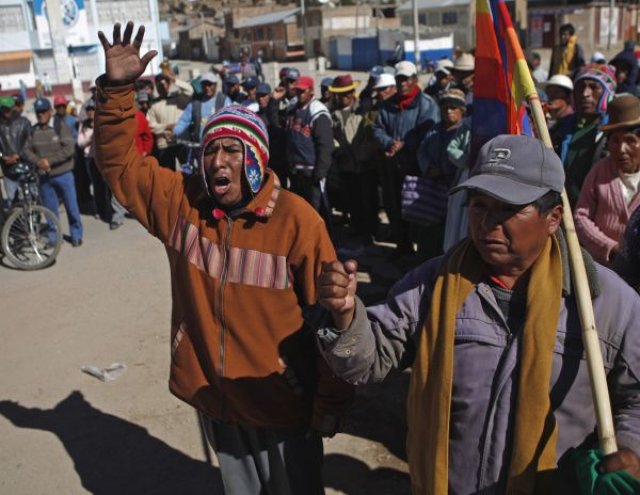
Corporate media outlets claim Peru’s mining boom is doing wonders for the country’s economy, creating opportunities and making everybody richer.
Quite a few Peruvians, mostly situated in the bubble-world of Lima’s wealthy areas, have been drinking the neoliberal kool-aid.
Someone must have forgotten to tell those troublesome recalcitrants out in the provinces that the despoliation of their lands is good for them.
Big protests erupted during April in Arequipa. In late May, there were further manifestations of popular outrage in the neighbouring province of Puno. These pitted local communities against foreign mining corporations and Peru's security forces.
The communities do not care about the statistical chicanery of Peru’s upward GDP growth. Instead, they would prefer an inhabitable country to live in.
Canadian Bear Creek Mining Corporation, whose money-making ventures benefit neither bears nor creeks, describes itself on its website as an “aggressive” explorer for precious metals in Peru.
By 2014, the company estimates it would boast an annual silver production of 15-20 million ounces, transforming it from a small exploration company to one of the biggest players.
It has recently announced plans to start operations at the Santa Ana silver mine, which it developed with minimal capital investment in collusion with the government of President Alan Garcia.
Other Bear Creek holdings in Peru include Corani, a much larger mine scheduled to come online by 2014.
Toxic cyanide leaching will be used to process the silver ore, a process that has often led to environmental contamination on a huge scale.
Leaks and spills are inevitable, in spite of the company’s standard denials and promises of jobs for locals.
All that will be left after the 11-14 years of the Santa Ana mine’s projected life is a toxic wasteland in the vulnerable highland country of Santa Ana and very possibly a Lake Titicaca devoid of fish stocks and polluted beyond repair.
Such an outcome would be disastrous not only for Puno’s farmers, but for Peru’s heritage.
Since 2002, more than 1.5 million hectares in Puno have been handed over to miners, heralding the imminent demise of this region’s ancient agricultural economy.
The story of Puno in south-eastern Peru, where precious water supplies have been diverted to mining at the expense of farmers, is being repeated all over the country.
Killings and mass arrests have accompanied the controversial sell-off, making Peru one of the world’s more dangerous places to carry an anti-mining placard.
With no other way to be heard, protesters have responded to Bear Creek’s declaration which Garcia has publicly endorsed with his usual bombast by blockading more than 300 kilometres of roads and shutting down the entire province.
The streets of the regional capital, Puno, have been repeatedly taken over by crowds of sling-wielding demonstrators. The protests have been so large that police have had to back off even when the offices of the government tax agency went up in flames.
Clearly, Puno’s mainly Aymara-speaking indigenous inhabitants support the ongoing popular protests, which are aimed at forcing the government to cancel Bear Creek’s licence.
They never said yes to the mine. No one asked them.
Garcia has responded with typically dismissive arrogance, labelling the protesters “irrational”. They are far from it.
Peru has been identified in many studies, including one published by Manchester University’s School of Environment and Development (SED), as “South America’s most water-stressed country”.
SED said: “Water draining from the Andean highlands ... serves as a water tower that supports … agricultural activities.”
Glacier melt due to climate change has adversely effected this cycle. “Further pressure comes from the rapid expansion of mining in Peru [because] many mining concessions are located in headwater areas in the high Andes … Mining can adversely affect water quality, and these impacts on quality can extend well beyond the mine site, relayed across space by rivers and aquifers.
“They can also extend over time, lasting generations.”
This defilement of the land is what the people of Puno are resisting.
Underlying the mining boom is a one-sided power relationship that is the product of centuries of imperialism.
In the past decade, the foreign-backed Peruvian oligarchy has handed out mining concessions to all and sundry with utter contempt for the objections voiced by local inhabitants.
Peru faces a presidential run-off election on June 5 between the neoliberal Keiko Fujimor and the left-leaning nationalist Ollanta Humala.
Should Fujimori win, an outcome recent polls are predicting, it is certain this trend will accelerate.
Like her disgraced ex-dictator father, who directs virtually every aspect of his 36-year-old corporate lawyer daughter's campaign from his luxury prison, Fujimori is a right-wing “pro-business” ideologue.
Under Peru’s constitution, the government can temporarily disenfranchise an entire region when serious public disorder coincides with an election.
One of Peru’s most prominent journalists, Rosa Maria Palacios of Prensa Libre, has recently accused Garcia of deliberately provoking the people of Puno in order to cancel their participation in elections.
Whether true or not, it is well-known that Garcia, who is reportedly planning yet another comeback in 2016, favours a Fujimori succession.
In the first round, the vote in Puno overwhelmingly went to Humala.
It remains to be seen what would transpire in terms of genuine environmental reform should the left-leaning Humala (who trails Fujimori by about five percentage points) win the election.
In Arequipa, three protesters had to die before the outgoing Garcia administration started listening.
Given the government’s trigger-happy approach to dissent, it is possible that blood will also be shed in Puno, where protesters have pledged that they too are prepared to give their lives.
What choice do they have?